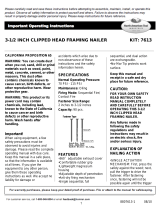
3
Eye protection can be bought at any hardware store.
Always wear eye protection while operating this
tool. Use either eye protection or a wide vision mask
over prescription glasses, the quality of which
should be equivalent to the requirements of AS/NZS
1337:1992 Eye protectors for industrial applications.
Employers should always enforce the use of eye
protection equipment.
6. Protect your ears and head.
When engaged in nailing work please wear ear
mufflers and head protection. Also, depending on
condition, ensure that surrounding people also wear
ear mufflers and head protection.
Recommended ear mufflers should be equivalent
to the requirements of AS/NZS 1270:1999 Acoustics-
Hearing Protectors.
7. Pay attention to those working close to you.
It would be very dangerous if nails that were not
properly driven in should hit other people.
Therefore, always pay attention to the safety of the
people around you when using this tool. Always
make sure that nobody’s body, hands or feet are
close to the nail outlet.
8. Never point the nail outlet towards people.
Always assume the tool contains fasteners.
If the nail outlet is pointed towards people, serious
accidents may be caused if you mistakenly discharge
the tool. When connecting and disconnecting the
hose, during nail loading or similar operations, be
sure the nail outlet is not pointed towards anyone
(including yourself). Even when no nails are loaded
at all, it is dangerous to discharge the tool while
pointing it at someone, so never attempt to do so.
No horseplay. Respect the tool as a working
implement.
9. Before using the power tool, check the push lever.
Before using the power tool make sure to check that
the push lever and valve operate properly. Without
nails loaded into the power tool, connect the hose
and check the following. If the sound of operation
occurs this indicates a fault, so in such a case do
not use the power tool until it has been inspected
and repaired.
䡬 If merely pulling the trigger causes operating
sound of drive bit movement occur, the power
tool is faulty.
䡬 If merely pushing the push lever against the
material to be nailed causes the sound of drive
bit movement to occur, the power tool is faulty.
Furthermore, with regard to the push lever, please
note that it must never be modified or removed.
10. Use specified nails only.
Never use nails other than those specified and
described in these instructions.
11. Be careful when connecting the hose.
When connecting the hose and loading nails in order
not to fire the tool by mistake, make sure of the
followings.
䡬 Do not touch the trigger.
䡬 Do not allow the firing head to contact with any
surface.
䡬 Keep the firing head down.
Strictly observe the above instructions, and always
make sure that no part of the body, hands or
legs is ever in front of the nail outlet.
12. Do not carelessly place your finger on the trigger.
Do not place your finger on the trigger except when
actually nailing. If you carry this tool or hand it to
someone while having your finger on the trigger,
you may inadvertently discharge a nail and thus
cause an accident.
13. Press the nail outlet firmly against the material to
be nailed.
When driving in nails, press the nail outlet firmly
against the material to be nailed. If the outlet is not
applied properly, the nails may rebound.
14. Keep hands and feet away from the firing head
when using.
It is very dangerous for a nail to hit the hands or
feet by mistake.
15. Beware of the tool’s kickback.
Do not approach the top of the tool with your head
etc. during operation. This is dangerous because the
tool may recoil violently if the nail currently being
driven in comes into contact with a previous nail or
a knot in the wood.
16. Take care when nailing thin boards or the corners
of wood.
When nailing thin boards, the nails may pass right
through, as may also be the case when nailing the
corners of wood due to deviation of the nails. In such
cases, always make sure that there is no one (and
nobody’s hands or feet; etc.) behind the thin board
or next to the wood you are going to nail.
17. Simultaneous nailing on both sides of the same wall
is dangerous.
Under no circumstances should nailing be
performed on both sides of a wall at the same time.
This would be very dangerous since the nails might
pass through the wall and thus cause injuries.
18. Do not use the power tool on scaffoldings, ladders.
The power tool shall not be used for specific
application for example:
– when changing one driving location to another
involves the use of scafforldings, stairs, ladders
or ladder alike constructions, e.g. roof laths,
– closing boxes or crates,
– fitting transportation safety systems e.g. on
vehicles and wagons
19. Do not disconnect the hose with your finger on the
trigger.
If you disconnect the hose with your finger on the
trigger, the next time the hose is connected, there
is a danger that the power tool will fire a nail
spontaneously, or operate incorrectly.
20. Disconnect the hose and take out any nails left in
the magazine after use.
Disconnect tool from air before doing tool
maintenance, cleaning a jammed fastener, leaving
work area, moving tool to another location, or after
use. It is very dangerous for a nail to be fired by
mistake.
21. When removing a nail which has become stuck,
make sure to first of all disconnect the hose and
release compressed air.
When removing a nail which has become stuck in
the nail outlet, first of all make sure to disconnect
the hose and release compressed air inside the
power tool.
Accidental firing of the nail could be very dangerous.
01Eng_NR90AD_Eng 27/6/07, 11:493













